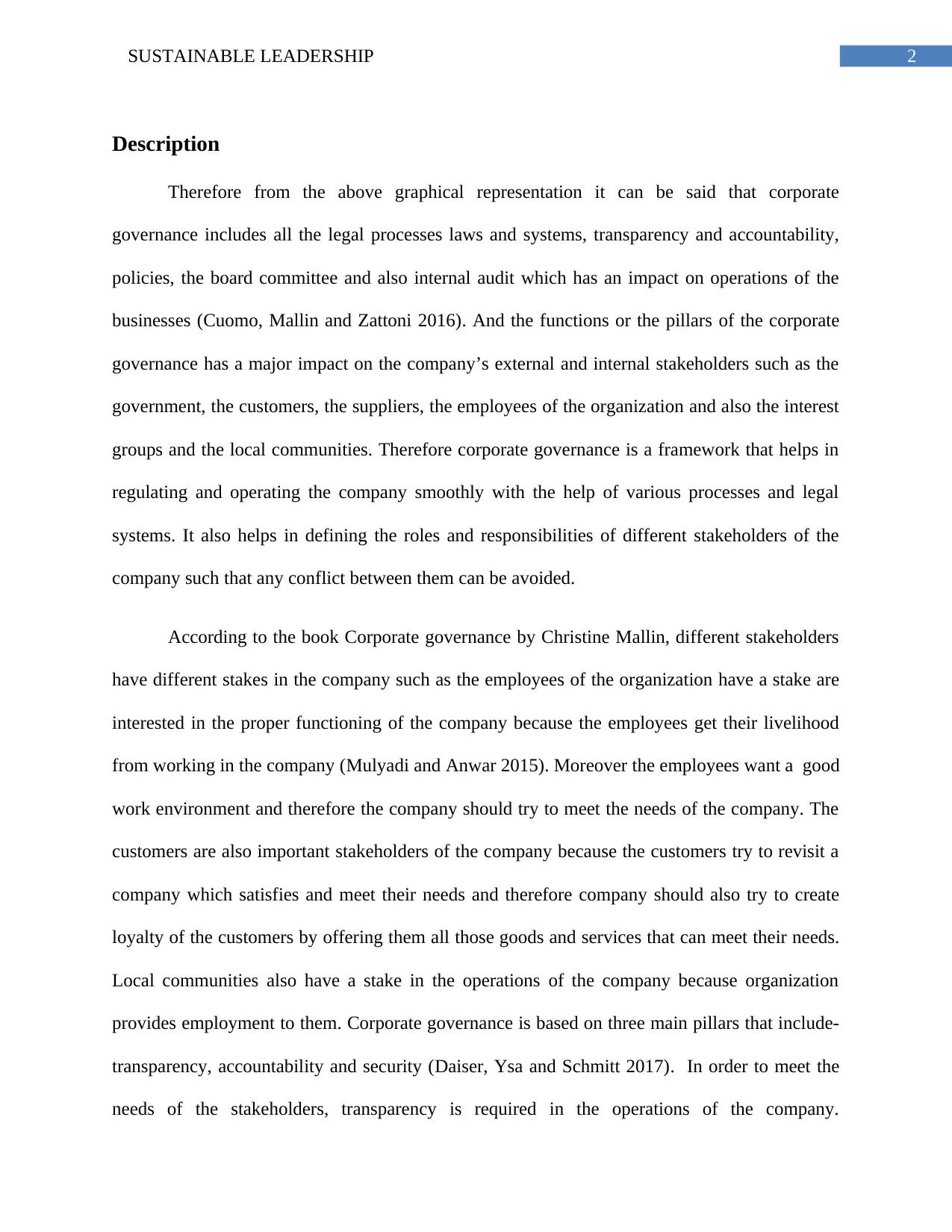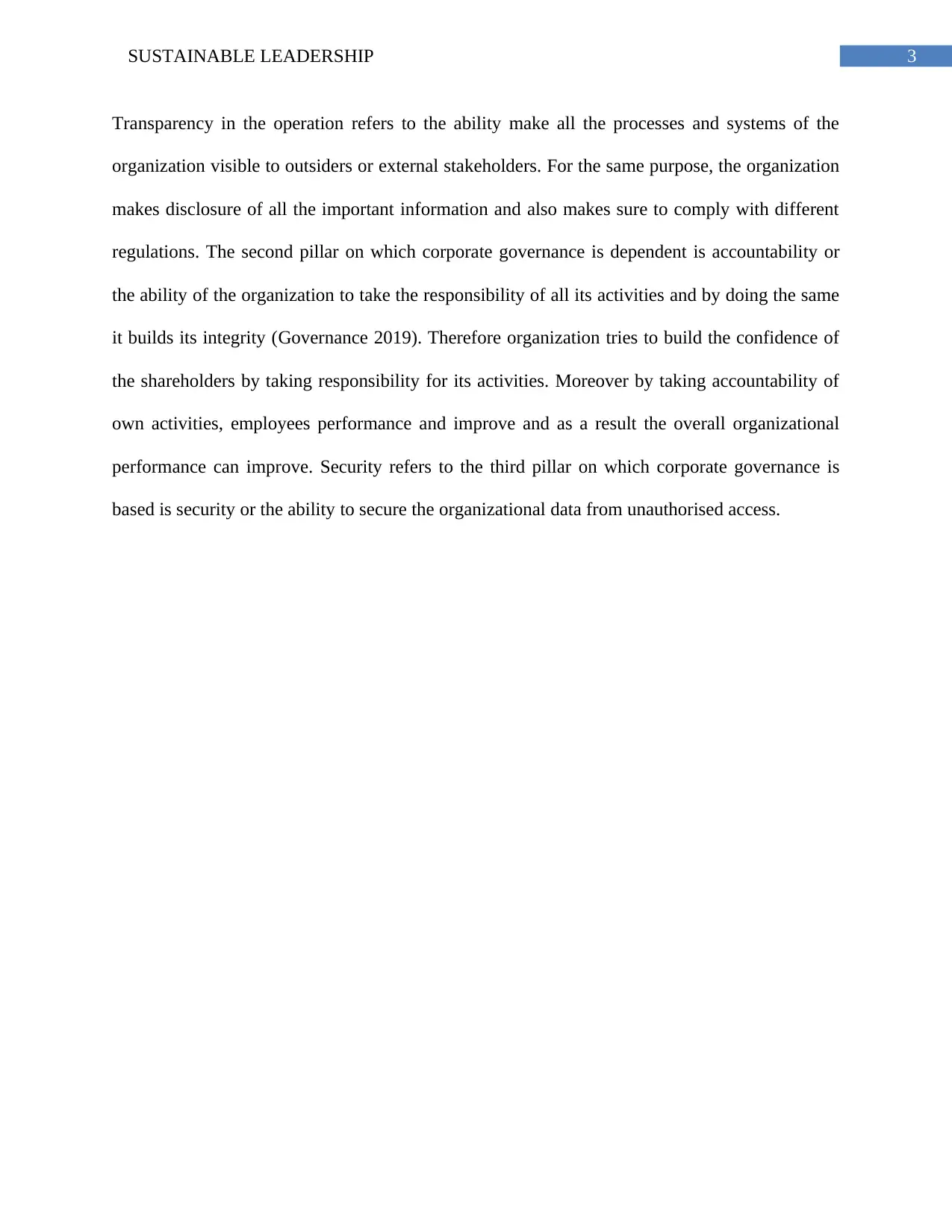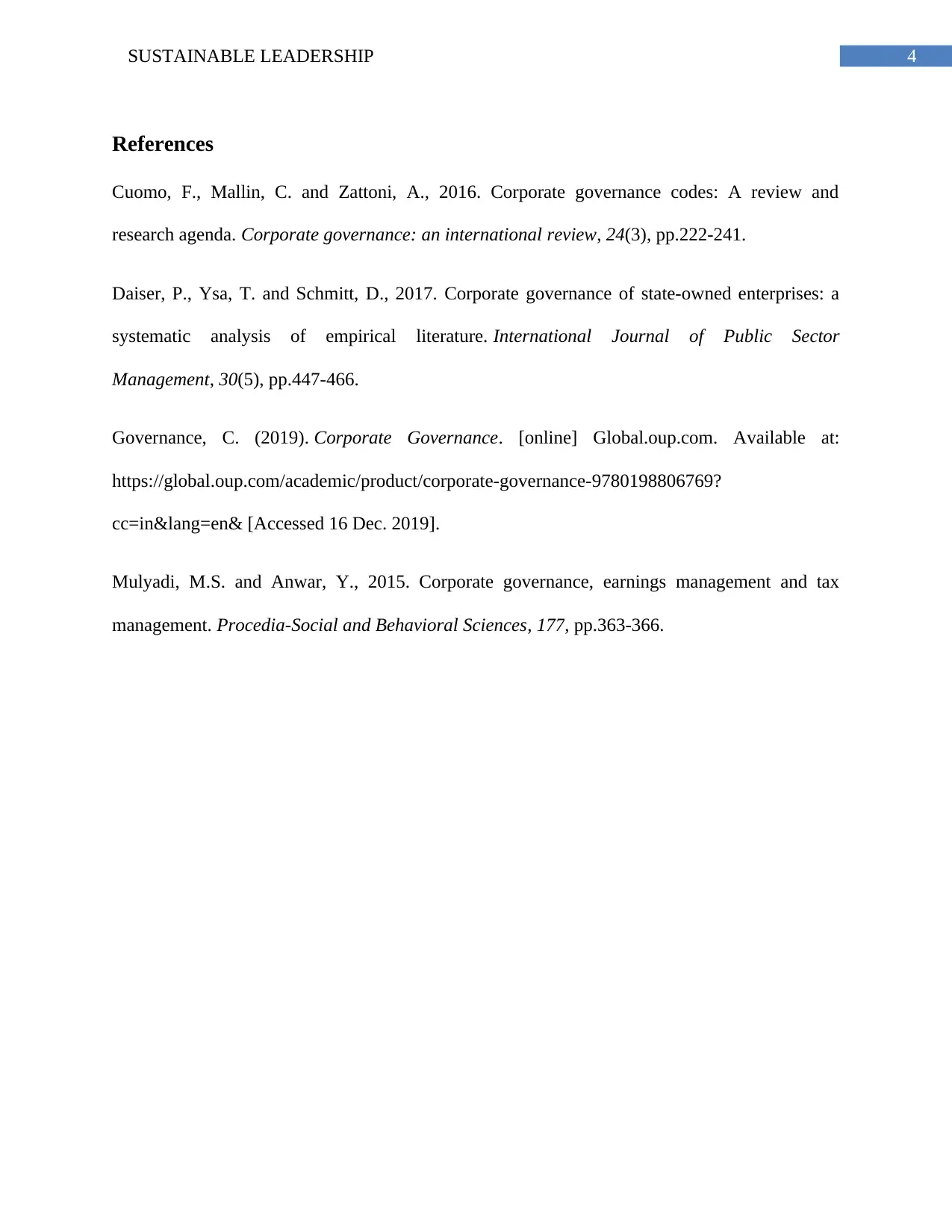Corporate Governance: A Comprehensive Report and Analysis
VerifiedAdded on 2022/09/09
|5
|728
|24
Report
AI Summary
This report addresses the core concepts of corporate governance, exploring its definition, main actors, and the key issues and factors that shape its structure. The assignment involves a comprehensive literature review, including the use of Christine A. Mallin's book and additional peer-reviewed articles. The analysis covers the roles of various stakeholders, such as government, customers, employees, and local communities, and highlights the importance of transparency, accountability, and security within the corporate governance framework. The report also features a graphical mind-map/illustration providing a visual representation of the student's understanding of corporate governance based on the literature review, accompanied by a detailed explanation of its key components.

Running head: SUSTAINABLE LEADERSHIP
SUSTAINABLE LEADERSHIP
Name of Student
Name of the University
Author Note
SUSTAINABLE LEADERSHIP
Name of Student
Name of the University
Author Note
Paraphrase This Document
Need a fresh take? Get an instant paraphrase of this document with our AI Paraphraser

1SUSTAINABLE LEADERSHIP
Graphical representation
Corpora
te gov
Policies
esInternal
audit
Transparen
cy
Legal
systems
Systems
Board
Committee
s
Accountab
ility
Stakeholder
1:government
Stakeholder
2: customers
Stakeholder
3: interest
groups
Stakeholder
4:
employees
Stakeholder
5:
community
Graphical representation
Corpora
te gov
Policies
esInternal
audit
Transparen
cy
Legal
systems
Systems
Board
Committee
s
Accountab
ility
Stakeholder
1:government
Stakeholder
2: customers
Stakeholder
3: interest
groups
Stakeholder
4:
employees
Stakeholder
5:
community

2SUSTAINABLE LEADERSHIP
Description
Therefore from the above graphical representation it can be said that corporate
governance includes all the legal processes laws and systems, transparency and accountability,
policies, the board committee and also internal audit which has an impact on operations of the
businesses (Cuomo, Mallin and Zattoni 2016). And the functions or the pillars of the corporate
governance has a major impact on the company’s external and internal stakeholders such as the
government, the customers, the suppliers, the employees of the organization and also the interest
groups and the local communities. Therefore corporate governance is a framework that helps in
regulating and operating the company smoothly with the help of various processes and legal
systems. It also helps in defining the roles and responsibilities of different stakeholders of the
company such that any conflict between them can be avoided.
According to the book Corporate governance by Christine Mallin, different stakeholders
have different stakes in the company such as the employees of the organization have a stake are
interested in the proper functioning of the company because the employees get their livelihood
from working in the company (Mulyadi and Anwar 2015). Moreover the employees want a good
work environment and therefore the company should try to meet the needs of the company. The
customers are also important stakeholders of the company because the customers try to revisit a
company which satisfies and meet their needs and therefore company should also try to create
loyalty of the customers by offering them all those goods and services that can meet their needs.
Local communities also have a stake in the operations of the company because organization
provides employment to them. Corporate governance is based on three main pillars that include-
transparency, accountability and security (Daiser, Ysa and Schmitt 2017). In order to meet the
needs of the stakeholders, transparency is required in the operations of the company.
Description
Therefore from the above graphical representation it can be said that corporate
governance includes all the legal processes laws and systems, transparency and accountability,
policies, the board committee and also internal audit which has an impact on operations of the
businesses (Cuomo, Mallin and Zattoni 2016). And the functions or the pillars of the corporate
governance has a major impact on the company’s external and internal stakeholders such as the
government, the customers, the suppliers, the employees of the organization and also the interest
groups and the local communities. Therefore corporate governance is a framework that helps in
regulating and operating the company smoothly with the help of various processes and legal
systems. It also helps in defining the roles and responsibilities of different stakeholders of the
company such that any conflict between them can be avoided.
According to the book Corporate governance by Christine Mallin, different stakeholders
have different stakes in the company such as the employees of the organization have a stake are
interested in the proper functioning of the company because the employees get their livelihood
from working in the company (Mulyadi and Anwar 2015). Moreover the employees want a good
work environment and therefore the company should try to meet the needs of the company. The
customers are also important stakeholders of the company because the customers try to revisit a
company which satisfies and meet their needs and therefore company should also try to create
loyalty of the customers by offering them all those goods and services that can meet their needs.
Local communities also have a stake in the operations of the company because organization
provides employment to them. Corporate governance is based on three main pillars that include-
transparency, accountability and security (Daiser, Ysa and Schmitt 2017). In order to meet the
needs of the stakeholders, transparency is required in the operations of the company.
⊘ This is a preview!⊘
Do you want full access?
Subscribe today to unlock all pages.

Trusted by 1+ million students worldwide

3SUSTAINABLE LEADERSHIP
Transparency in the operation refers to the ability make all the processes and systems of the
organization visible to outsiders or external stakeholders. For the same purpose, the organization
makes disclosure of all the important information and also makes sure to comply with different
regulations. The second pillar on which corporate governance is dependent is accountability or
the ability of the organization to take the responsibility of all its activities and by doing the same
it builds its integrity (Governance 2019). Therefore organization tries to build the confidence of
the shareholders by taking responsibility for its activities. Moreover by taking accountability of
own activities, employees performance and improve and as a result the overall organizational
performance can improve. Security refers to the third pillar on which corporate governance is
based is security or the ability to secure the organizational data from unauthorised access.
Transparency in the operation refers to the ability make all the processes and systems of the
organization visible to outsiders or external stakeholders. For the same purpose, the organization
makes disclosure of all the important information and also makes sure to comply with different
regulations. The second pillar on which corporate governance is dependent is accountability or
the ability of the organization to take the responsibility of all its activities and by doing the same
it builds its integrity (Governance 2019). Therefore organization tries to build the confidence of
the shareholders by taking responsibility for its activities. Moreover by taking accountability of
own activities, employees performance and improve and as a result the overall organizational
performance can improve. Security refers to the third pillar on which corporate governance is
based is security or the ability to secure the organizational data from unauthorised access.
Paraphrase This Document
Need a fresh take? Get an instant paraphrase of this document with our AI Paraphraser

4SUSTAINABLE LEADERSHIP
References
Cuomo, F., Mallin, C. and Zattoni, A., 2016. Corporate governance codes: A review and
research agenda. Corporate governance: an international review, 24(3), pp.222-241.
Daiser, P., Ysa, T. and Schmitt, D., 2017. Corporate governance of state-owned enterprises: a
systematic analysis of empirical literature. International Journal of Public Sector
Management, 30(5), pp.447-466.
Governance, C. (2019). Corporate Governance. [online] Global.oup.com. Available at:
https://global.oup.com/academic/product/corporate-governance-9780198806769?
cc=in&lang=en& [Accessed 16 Dec. 2019].
Mulyadi, M.S. and Anwar, Y., 2015. Corporate governance, earnings management and tax
management. Procedia-Social and Behavioral Sciences, 177, pp.363-366.
References
Cuomo, F., Mallin, C. and Zattoni, A., 2016. Corporate governance codes: A review and
research agenda. Corporate governance: an international review, 24(3), pp.222-241.
Daiser, P., Ysa, T. and Schmitt, D., 2017. Corporate governance of state-owned enterprises: a
systematic analysis of empirical literature. International Journal of Public Sector
Management, 30(5), pp.447-466.
Governance, C. (2019). Corporate Governance. [online] Global.oup.com. Available at:
https://global.oup.com/academic/product/corporate-governance-9780198806769?
cc=in&lang=en& [Accessed 16 Dec. 2019].
Mulyadi, M.S. and Anwar, Y., 2015. Corporate governance, earnings management and tax
management. Procedia-Social and Behavioral Sciences, 177, pp.363-366.
1 out of 5
Related Documents
Your All-in-One AI-Powered Toolkit for Academic Success.
+13062052269
info@desklib.com
Available 24*7 on WhatsApp / Email
![[object Object]](/_next/static/media/star-bottom.7253800d.svg)
Unlock your academic potential
Copyright © 2020–2025 A2Z Services. All Rights Reserved. Developed and managed by ZUCOL.





